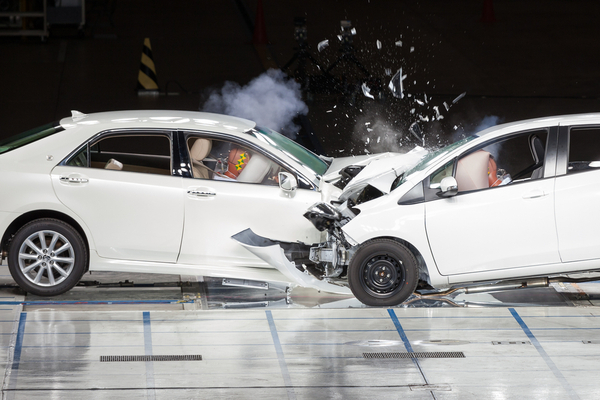For years now, automakers have been stuffing their cars with loads of advanced technology on the promise that all these sensors and software will make for a less deadly driving experience. But new research suggests that new technology isn’t doing enough to keep pedestrians safe.
The American Automobile Association (AAA) conducted a series of tests using vehicles with automatic emergency braking and pedestrian detection alerts on a closed course with dummy pedestrians. And what they found was highly upsetting. The vehicles struck the dummy pedestrians that were crossing the road 60 percent of the time — and this was in daylight hours at speeds of 20 mph. The researchers then swapped the adult dummies with a child-sized version, and the results got much, much worse: a collision occurred 89 percent of the time. Testing at night or at higher speeds also yielded a distressing number of collisions. When encountering an adult pedestrian at night, these supposed high-tech detection systems were “ineffective,” AAA says. None of the cars tested were able to detect an adult pedestrian at night.
Four model year 2019 vehicles were used in AAA’s testing: Chevy Malibu, Honda Accord, Tesla Model 3, and Toyota Camry. Each vehicle was outfitted with sensors and cameras to capture information about vehicle dynamics, position data, and visual notifications from the detection systems. The researchers tested several other scenarios, including encountering a pedestrian after a right-hand turn and two adults standing alongside the road with their backs to traffic. The latter scenario resulted in a collision 80 percent of the time, while the former yielded a 100 percent collision rate.
This new research comes at a time when pedestrian deaths are rising at a disturbing rate. According to the Governors Highway Safety Association, 6,227 pedestrians were killed on US roads in 2018, the highest number in nearly three decades. There are a number of contributing factors, including dangerous infrastructure, unsafe driving behaviors, and the insatiable need of the American car consumer for bigger trucks and SUVs. In fact, America’s favorite motor vehicle type is also the most deadly. The number of pedestrians killed in crashes involving SUVs has skyrocketed by 81 percent in the last decade, according to a report released in 2018 by the Insurance Institute for Highway Safety.
This is mostly because of the way SUVs are designed: larger bodies and higher carriage mean pedestrians are more likely to suffer deadly blows to the torso. And higher clearance means victims are more likely to get trapped underneath a speeding SUV instead of pushed onto the hood or off to the side. Speed is also a factor because SUVs have more horsepower than a typical sedan. A recent investigation by USA Today and the Detroit Free Press found that the growing popularity of SUVs accounts for the alarming rise in pedestrian deaths.
Back in 2016, 20 automakers told the National Highway Traffic Safety Administration (NHTSA) that they would make automatic emergency braking standard by 2022. In an update provided earlier this year, 10 automakers reported equipping more than half of the vehicles they produced between September 1st, 2017 and August 31st, 2018, with automatic emergency braking (AEB) system. The Insurance Institute for Highway Safety estimates that AEB may help prevent 28,000 crashes and 12,000 injuries by 2025.
The automakers for the models used in the tests have varied responses. In a statement, Toyota declined to comment on the overall message of the AAA report, but said “[i]t should be noted” that the Camry stopped 100 percent of the time, with an average 4.60 feet clearance to the pedestrian, in one of the test scenarios. GM’s safety features are designed for “real-world crash conditions,” the automaker for the Chevy Malibu said in a statement, while going on to note that other studies have shown AEB is effective in reducing rear-end crash rates by 44 percent. “Active Safety technology is truly a benefit to our customers,” the spokesperson said, “however these features do not replace the primary responsibility of the driver.”
Honda, for its part, acknowledged some of the limitations of its safety tech. “AAA testing of these systems at night speaks to the limitations present in all such driver-assistive systems, where technologies such as cameras, used primarily for object recognition, have diminished capacities in low-light and other conditions such as rain, snow and fog,” a spokesperson said. Tesla has not yet responded to requests from the media.
AAA sees a silver lining in these horrific results. New technology can still alert drivers in some scenarios, which lessens the likelihood of a crash. Automakers are on the right path with the development of these systems. But clearly they have a long way to go before drivers or pedestrians can count on them to perform in a consistent manner.
—
Photo Credit: Benoist / Shutterstock.com
